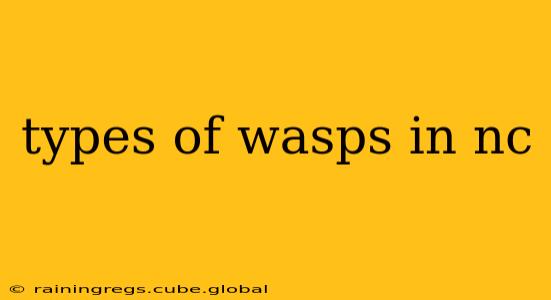Types of Wasps in North Carolina: A Comprehensive Guide
North Carolina, with its diverse ecosystems ranging from mountains to coastal plains, boasts a wide variety of wasp species. Understanding the different types is crucial for safety and effective pest management. This guide explores some of the most common wasps found in NC, their characteristics, and how to identify them.
What are the most common types of wasps in NC?
This is a broad question, as "common" can vary by location and season. However, some of the most frequently encountered wasps in North Carolina include:
-
Paper Wasps: These social wasps build characteristic open-comb nests, often under eaves, decks, or in sheltered areas. They are typically slender with long legs and are generally less aggressive than yellow jackets unless their nest is disturbed. Several species exist in NC, varying slightly in color and size.
-
Yellow Jackets: These are arguably the most notorious wasps in NC. Highly social and aggressive, they build nests in the ground, walls, or attics. They are easily identifiable by their bright yellow and black markings. Their stings are painful and can cause allergic reactions in sensitive individuals. Several subspecies exist, differing slightly in appearance and nesting habits.
-
Bald-faced Hornets: While technically a type of yellow jacket, bald-faced hornets are distinct. They are larger than most yellow jackets and have a predominantly black and white coloration. They build large, grayish-white, enclosed nests often high in trees or shrubs. Like yellow jackets, they are fiercely protective of their nests.
-
Cicada Killers: These large, solitary wasps are intimidating in appearance, but generally not aggressive unless directly handled. They are known for their impressive size and their role in parasitizing cicadas. Their nests are typically burrows in the ground.
-
Mud Daubers: These solitary wasps are easily identified by their long, slender bodies and their mud nests. They are generally non-aggressive and pose little threat to humans. Different types of mud daubers exist, building various nest structures.
What is the difference between wasps, hornets, and yellow jackets?
The terms "wasp," "hornet," and "yellow jacket" are often used interchangeably, leading to confusion. However, there are distinctions:
-
Wasps: This is a broad term encompassing a vast number of species. It refers to insects with narrow waists, four wings, and stinging females.
-
Hornets: Hornets are a specific type of social wasp, typically larger and more aggressive than other wasps. Bald-faced hornets, for example, are a type of hornet.
-
Yellow Jackets: Yellow jackets are another specific type of social wasp, known for their bright yellow and black markings and aggressive behavior.
How can I identify wasps in my yard?
Accurate identification requires careful observation. Consider these factors:
-
Size and Coloration: Note the wasp's size, body shape, and color patterns. Photographs can be helpful for comparison.
-
Nest Location and Structure: The location and structure of the nest provide valuable clues. Paper wasps build open combs, while yellow jackets and bald-faced hornets construct enclosed nests.
-
Behavior: Observe the wasp's behavior. Are they aggressive? Do they seem solitary or social?
Consult online resources like the North Carolina State University Extension website or field guides for detailed information and images to aid in identification.
Are all wasps in NC dangerous?
While many wasps in NC are capable of stinging, most are not inherently aggressive and will only sting if provoked (e.g., if their nest is threatened). Yellow jackets and bald-faced hornets are exceptions, known for their defensive behavior. However, even non-aggressive species can sting if accidentally handled.
What should I do if I find a wasp nest?
If you discover a wasp nest, especially one of a highly aggressive species, it's best to leave it alone and contact a pest control professional for removal. Attempting to remove a nest yourself can result in multiple stings.
This guide provides a starting point for understanding the diverse wasp population in North Carolina. Remember that accurate identification is key to effective management and safety. Always prioritize caution and seek professional assistance when dealing with wasp nests.
